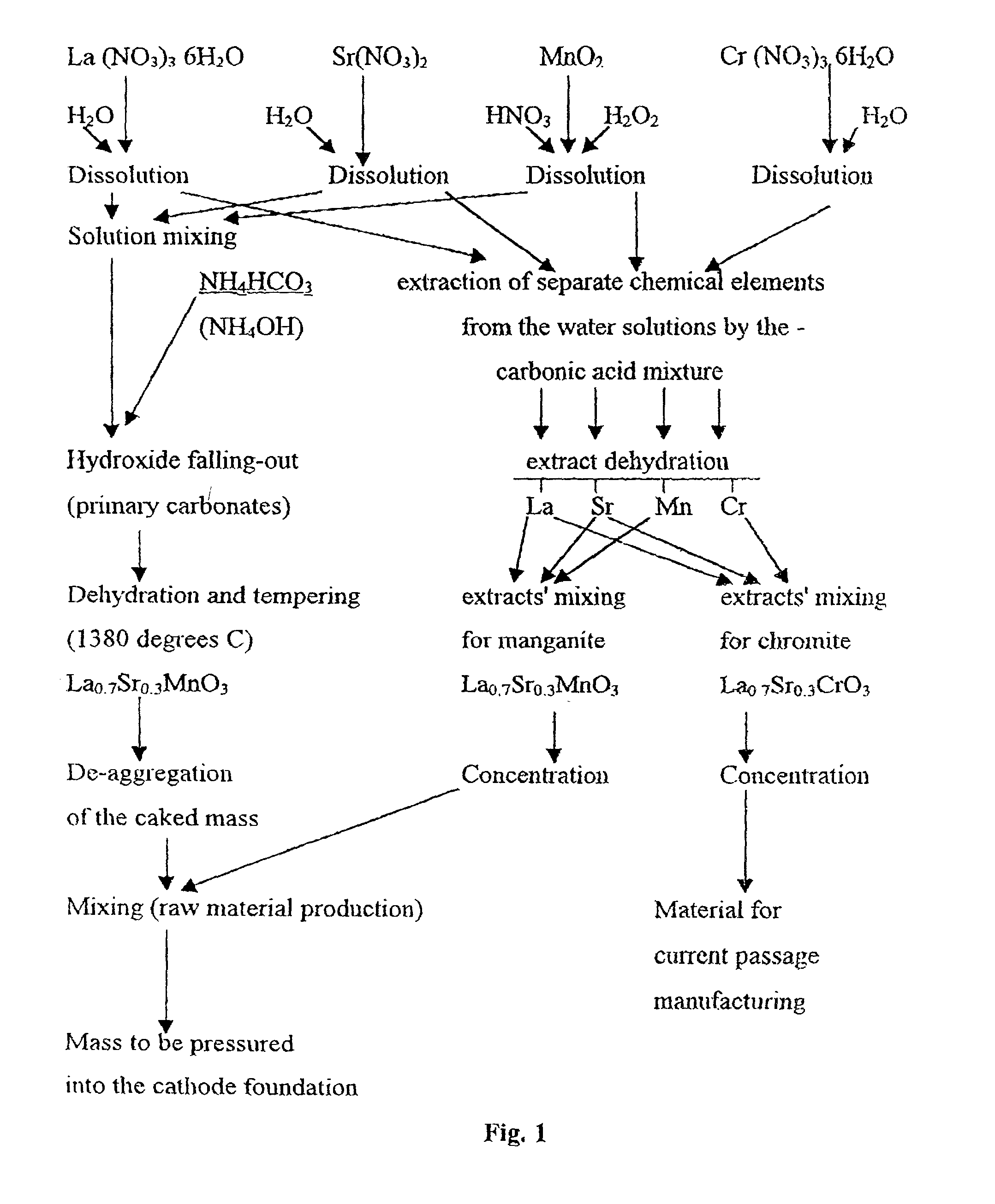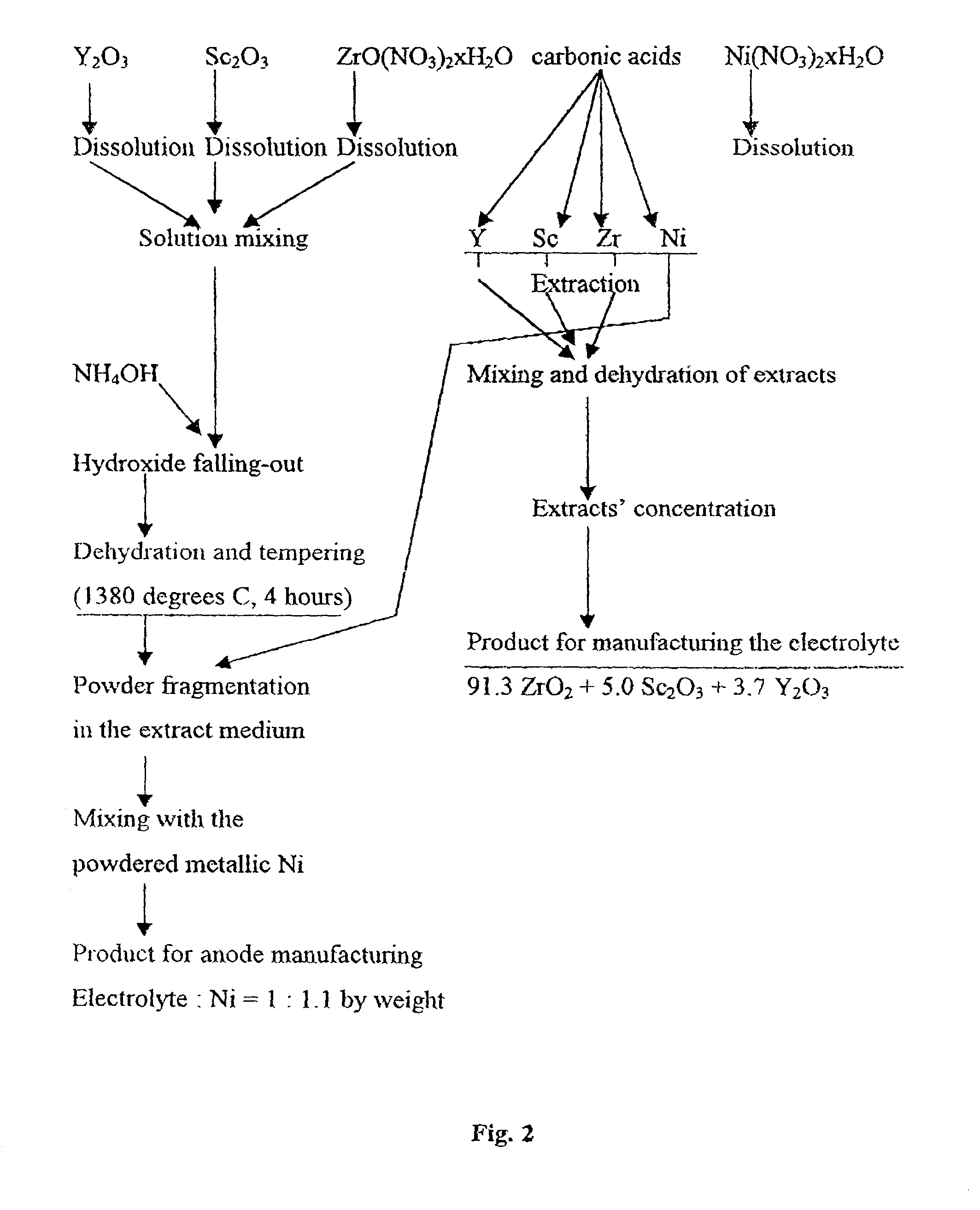Method for manufacturing a single high-temperature fuel cell and its components
a high-temperature fuel cell and manufacturing method technology, applied in the direction of fuel cells, electrochemical generators, electrical equipment, etc., can solve the problems of increasing and complicated specific demands on htfc construction, limiting the application of known ceramic technologies and materials in forming htfc components, and inability to divide and independent cell manufacturing conditions
- Summary
- Abstract
- Description
- Claims
- Application Information
AI Technical Summary
Problems solved by technology
Method used
Image
Examples
example 2
[0237] A mixture of La.sub.0.7Sr.sub.0.3MnO.sub.3 powder and the solution of La, Sr, Mn carboxylates were prepared as described in the Example 1. The obtained mixture was heated, in air. to a temperature of 650.degree. C. for 45 minutes. The obtained powder was deaggregated, in order to destroy any unstable aggregates formed after thermal treatment. Further steps of manufacturing the tubular cathodes are similar to those indicated in the Example 1. The tube caking temperature was 1380.degree. C. The results of changing the strength of the articles are presented in Table 3.
5TABLE 3 N.sup.o of preliminary Porosity, Bending strength treatment cycles % kg per sq. cm 1 29.0 72.0 2 28.6 75.8 3 27.9 76.4 4 27.3 77.0 5 27.1 77.0
example 3
[0238] The powder of the La.sub.0.7Sr.sub.0.3MnO.sub.3 composition used in examples 1 and 2 was mixed with a mixture of carboxylates containing Co, La, and Sr in proportions corresponding to the La.sub.0.6Sr.sub.0.4CoO.su-b.3 composition. The indicated carboxylates were obtained by extracting the corresponding metals. The total concentration of metals was 291 g per kg. The tube manufacture was performed as indicated in example 1. The results of caking the tubes at various temperatures are presented in Table 4.
6TABLE 4 Bending N.sup.o of Caking Parameters strength, kg sample T, .degree. C. Time, Hour Porosity % per sq. cm 1 1200 1 39.0 55.0 2 1250 1 37.5 57.0 3 1300 1 32.2 70.0 4 1350 1 30.0 74.0
Preferred Embodiment of the Invention for Manufacturing the Interface Layer
example 4
[0239] In order to manufacture the interface layer, a CLS film of 0.3 to 0.6 .mu.m in thickness is applied onto the carrier porous cathode from the MLS manufactured as described in the example 1. The step of applying is performed by painting the cathode surface, heated up to 530.degree. C, with the mixture of Cr, La, Sr carboxylates in the air atmosphere. The total concentration of Cr, La, Sr in the mixture of the carboxylates (converting to oxides) was 30 g per kg. The organic component of the carboxylates is represented by the mixture of the following composition:
7 Dimethyl-propyl-acetic acid C.sub.7H.sub.14O.sub.2 36% by weight, Dimethyl-butyl-acetic acid C.sub.8H.sub.16O.sub.2 31% by weight, Dimethyl-amyl-acetic acid C.sub.9H.sub.18O.sub.2 15% by weight, Dimethyl-hexyl-acetic acid C.sub.10H.sub.20O.sub.2 7% by weight, Dimethyl-lauryl-acetic acid C.sub.12H.sub.24O.sub.2 2% by weight.
[0240] The proportion of Cr, La, and Sr oxides after decomposing the mixture of carboxylates on th...
PUM
| Property | Measurement | Unit |
|---|---|---|
| Fraction | aaaaa | aaaaa |
| Fraction | aaaaa | aaaaa |
| Fraction | aaaaa | aaaaa |
Abstract
Description
Claims
Application Information
 Login to View More
Login to View More - R&D
- Intellectual Property
- Life Sciences
- Materials
- Tech Scout
- Unparalleled Data Quality
- Higher Quality Content
- 60% Fewer Hallucinations
Browse by: Latest US Patents, China's latest patents, Technical Efficacy Thesaurus, Application Domain, Technology Topic, Popular Technical Reports.
© 2025 PatSnap. All rights reserved.Legal|Privacy policy|Modern Slavery Act Transparency Statement|Sitemap|About US| Contact US: help@patsnap.com



